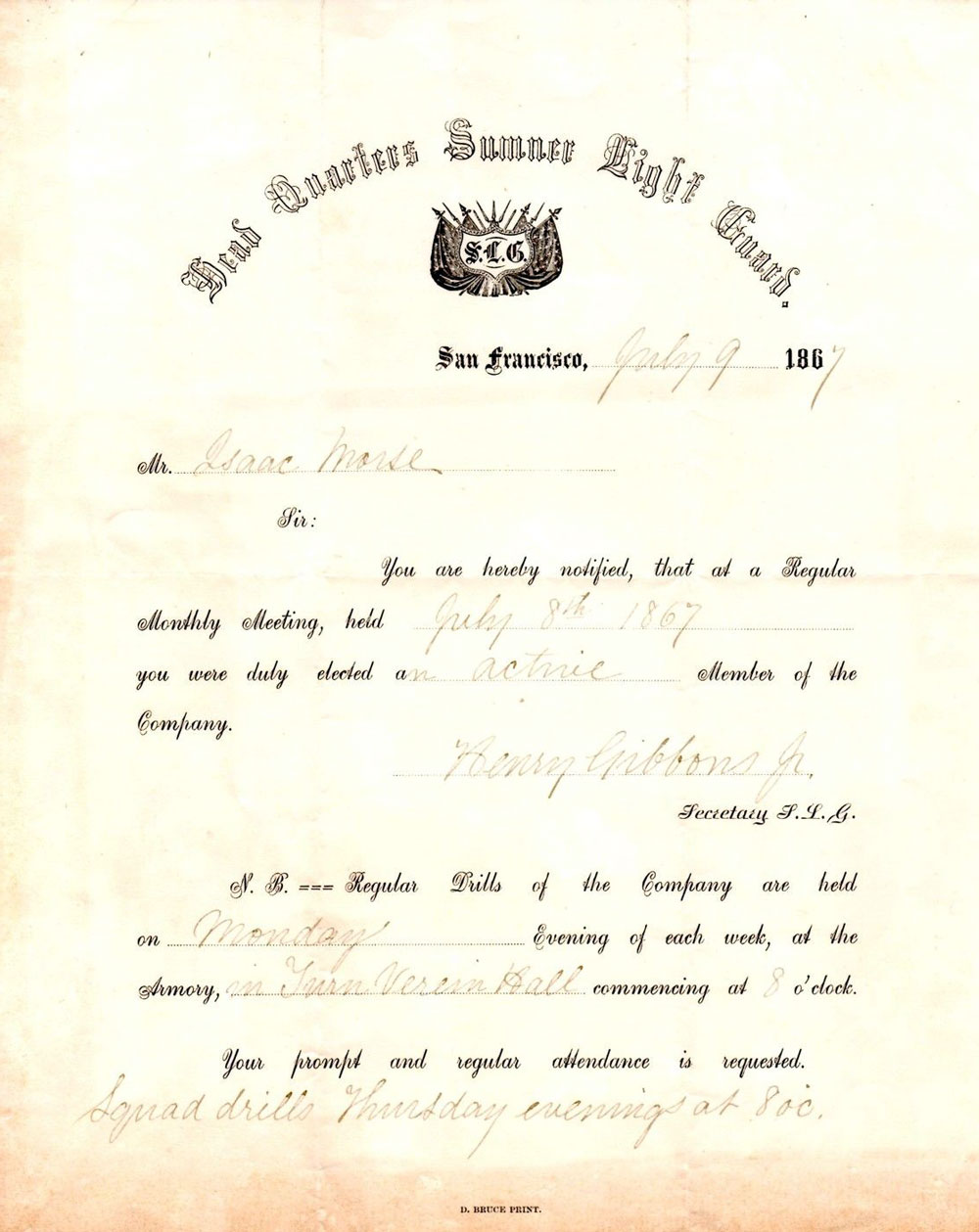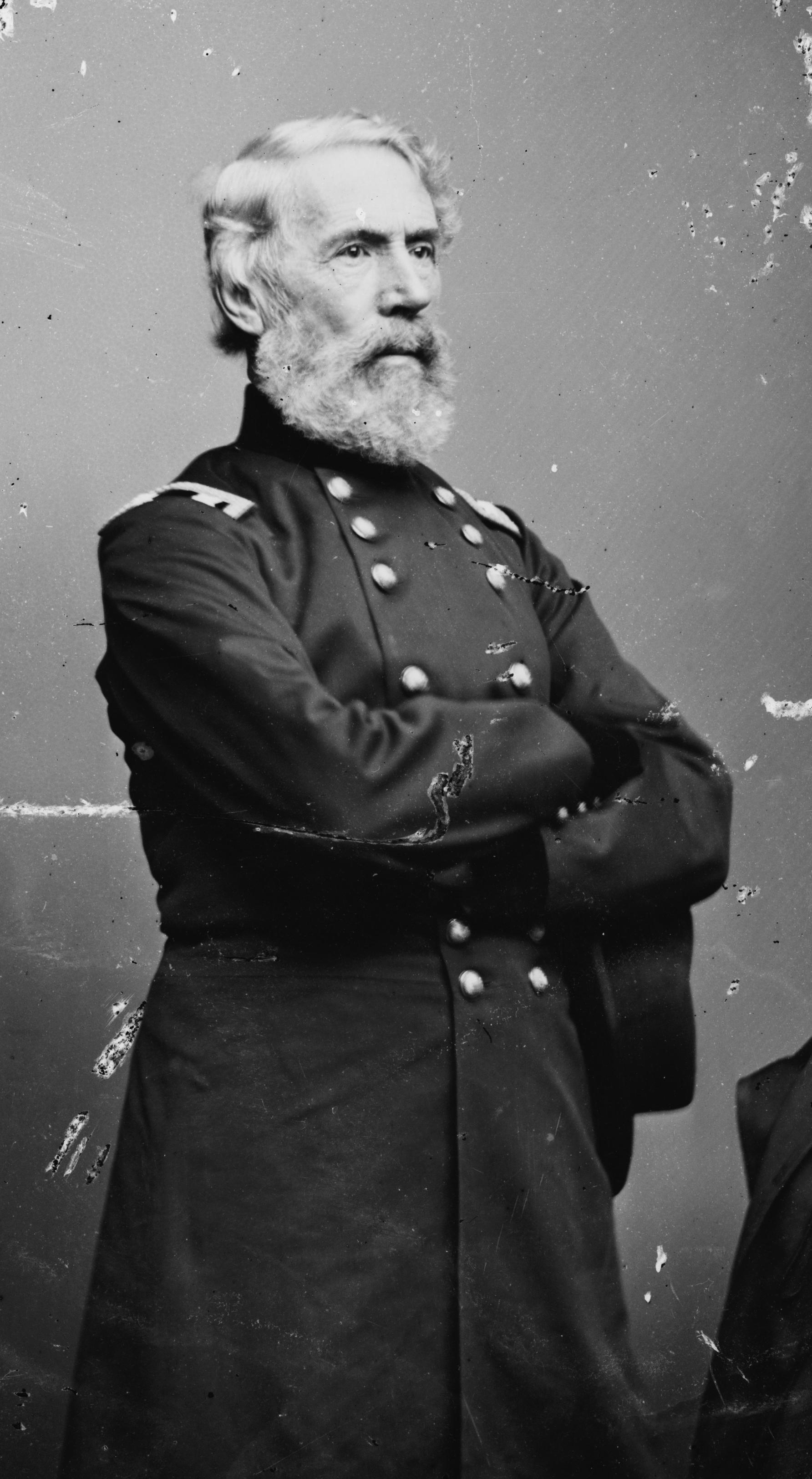

 On April
20, 1864, a military escort of six companies was ordered to attend
the funeral of the late Lieutenant Colonel Ringold. Two of the
companies were from the California Militia; they were the Sumner
Light Guard and the City Guard of San
Francisco ordered out for the occasion by General Allen and
under the command of Colonel Sibley.[1] On August 29 , 1877,
a leave of absence for sixty days was granted to Captain H. J
. Burns and Second Lieutenant Joshua Robertson, officers of the
Sumner Light Guard, to represent the National Guard of California
in the Interstate Military Match which was to be held that year
at Creedmoor, New York.[2] Upon their return Joshua Robertson
was elected First Lieutenant under Captain H. J. Burns, January
7, 1878. Distinction again was won along the same lines by the
Sumner Light Guard when the State Agricultural Society in conjunction
with the citizens of Sacramento, offered inducements in the way
of prizes for drill and marksmanship to military companies attending
the State Fair of 1878. A competitive rifle contest was held
under the supervision of Colonel James Laven, General Inspector
of rifle practice. Several companies participated in the contest
including the Sumner Light Guard, represented by their Captain,
H. J. Burns, who had previously excelled in marksmanship. Captain
Burns won first prize in the rifle contest, which consisted of
three hundred dollars and a gold medal presented to him by the
president of the State Agricultural Society: M. D. Boruch.[3]
On April
20, 1864, a military escort of six companies was ordered to attend
the funeral of the late Lieutenant Colonel Ringold. Two of the
companies were from the California Militia; they were the Sumner
Light Guard and the City Guard of San
Francisco ordered out for the occasion by General Allen and
under the command of Colonel Sibley.[1] On August 29 , 1877,
a leave of absence for sixty days was granted to Captain H. J
. Burns and Second Lieutenant Joshua Robertson, officers of the
Sumner Light Guard, to represent the National Guard of California
in the Interstate Military Match which was to be held that year
at Creedmoor, New York.[2] Upon their return Joshua Robertson
was elected First Lieutenant under Captain H. J. Burns, January
7, 1878. Distinction again was won along the same lines by the
Sumner Light Guard when the State Agricultural Society in conjunction
with the citizens of Sacramento, offered inducements in the way
of prizes for drill and marksmanship to military companies attending
the State Fair of 1878. A competitive rifle contest was held
under the supervision of Colonel James Laven, General Inspector
of rifle practice. Several companies participated in the contest
including the Sumner Light Guard, represented by their Captain,
H. J. Burns, who had previously excelled in marksmanship. Captain
Burns won first prize in the rifle contest, which consisted of
three hundred dollars and a gold medal presented to him by the
president of the State Agricultural Society: M. D. Boruch.[3]
 In
February 1861, Brig. Gen. David E. Twiggs was dismissed from
the Army for treason by outgoing U.S. President James Buchanan,
and on March 12, 1861, Sumner was nominated by the newly inaugurated
Lincoln to replace Twiggs as one of only three brigadier generals
in the regular army, with date of rank March 16. Sumner was thus
the first new Union general created by the secession crisis.
He was then sent to replace Brig. Gen. Albert Sidney Johnston,
then in command of the Department of the Pacific in California,
and thus took no part in the 1861 campaigns of the war. When
Sumner left for California, his son-in-law Armistead Lindsay
Long resigned his commission and enlisted with the Confederate
Army eventually becoming Robert E. Lee's military secretary and
an artillery brigadier general.
In
February 1861, Brig. Gen. David E. Twiggs was dismissed from
the Army for treason by outgoing U.S. President James Buchanan,
and on March 12, 1861, Sumner was nominated by the newly inaugurated
Lincoln to replace Twiggs as one of only three brigadier generals
in the regular army, with date of rank March 16. Sumner was thus
the first new Union general created by the secession crisis.
He was then sent to replace Brig. Gen. Albert Sidney Johnston,
then in command of the Department of the Pacific in California,
and thus took no part in the 1861 campaigns of the war. When
Sumner left for California, his son-in-law Armistead Lindsay
Long resigned his commission and enlisted with the Confederate
Army eventually becoming Robert E. Lee's military secretary and
an artillery brigadier general.